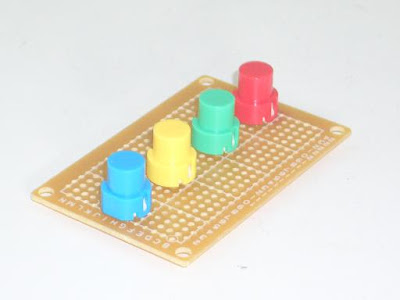Well, it's a little more complex to program flashing lights that beat to the music, but here's the next best thing. And it tests your sense of rhythm too! Mike played this one (I just shot the video), and it's surprisingly easy to put together. It took me maybe 10 minutes to throw together, and then I spent forever playing our homebrewed version of "Spotlight" Hero. I even brought my girlfriend and resident Guitar Hero expert over to play a few rounds!
To build all this, I just connected some colored lights up to the RelaySquid, and then controlled them with a few digital switches that I picked up from RadioShack. The circuit itself was powered by a Lithium Backpack that I strapped on to the setup.
First, I set up the colored buttons- but any plain old switches will do.
Next I connected the other side of each button to the respective relay you want it to control, and then I then secured the Lithium Backpack to the PC Board with the 4 Buttons on it. After that I connected each Button to the RelaySquid Digital Input that controls it’s respective color output. That meant I took the wire from the blue button, and tied one end to +5V, and the other end I plugged into the labeled pin on the RelaySquid that corresponded to the blue light. I also connected the Lithium Backpack’s +5V and GND to the RelaySquid’s respective inputs on J8.
I turned on the Backpack and press the buttons to test each Squid Relay (you should hear a click with each press). When this test worked ok, I plugged in each AC plug (including the power input coming from the RelaySquid.I made sure the lights were on, and then every time I pressed a button, the corresponding relay on the RelaySquid would turn on. That’s it! More details, pics and vids over on the projects page.


No comments:
Post a Comment